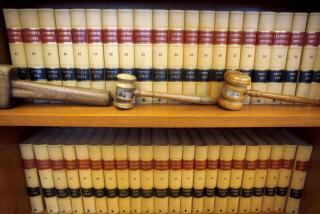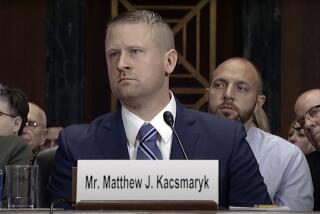Federal Court Survey Finds Gender Bias in 9th Circuit : Discrimination: Nearly 60% of female lawyers report harassment. The problem affects career advancement and outcome of cases involving women, they say.
SANTA BARBARA — Nearly 60% of women lawyers practicing in federal courts in California and eight other western states have experienced sexual harassment, according to a groundbreaking study by a special task force of the U.S. 9th Circuit Court of Appeals.
A third of female attorneys said a male colleague had harassed them in the last five years, 40% said a client had harassed them, and 6% said they had been harassed by a judge.
The 9th Circuit report is the first on gender bias by any of the nation’s 13 federal circuits, although similar studies have been conducted by 30 state courts in the last decade.
USC law professor Judith Resnik, one of the report’s primary authors, said that 3,409 lawyers and 232 judges were surveyed and that the study’s results are accurate within 3 percentage points. Detailed questionnaires prepared by Deborah R. Hensler, senior social scientist at the RAND Corp., were augmented by focus groups from across the circuit.
“The report is seriously path-breaking” and documents that “there are serious problems,” Resnik said.
“To do this report took leadership and a willingness to engage in critical self-analysis on a sensitive topic,” said U.S. District Judge John C. Coughenour of Seattle, the task force chairman. He was joined on the panel by U.S. District Judge Marilyn H. Patel of San Francisco, federal Appellate Judge Proctor Hug Jr. of Reno, attorneys M. Margaret McKeown of Seattle, Terry W. Bird and Henry Shields Jr. of Los Angeles, Resnik and Hensler.
The study does not use a single definition of sexual harassment. But it presents examples from interviews.
One female private practitioner said: “Once a stockbroker client of another (male) attorney tackled me to the ground in my office, and when I asked the other attorney to take control of the man, the (male) attorney said: ‘I don’t want to hear about it.’ Both men said: ‘You must be frigid.’ ”
Another woman said that during a pretrial deposition, “a male attorney placed his face near my derriere and asked if I was dieting. When I told the magistrate and the judge, they refused to even listen to me. The attorney had made numerous remarks about my body during the deposition in front of other lawyers and a doctor. I felt humiliated.”
A female judge said she heard other women judges complaining about sexual harassment by male judges. And “several court employees expressed discomfort about judges who sought to share with them pornographic material associated with obscenity cases . . . or who were insensitive to the employees’ wishes not to be exposed to such materials--for example, requiring employees to take the judge his mail while he is viewing pornographic movies.”
No individuals were identified in the report, but the subject seems to make some jurists nervous.
“This whole thing makes me very nervous. . . . The chance of someone making an offhand comment and getting into trouble,” said a male federal trial judge who has a good reputation with women lawyers.
But Los Angeles lawyer Carla M. Woehrle, a delegate to the 9th Circuit judicial conference meeting here last week, said the 300-page report “went a long way toward bringing to the forefront of people’s consciousness the need to address these problems.”
The study, formally adopted at the annual conference, said that although most gender bias in the 9th Circuit is subtle, it is nonetheless pervasive.
It affects the outcome of cases involving women, women’s possibilities of advancing in the legal profession and how they are treated in the courtroom. The report states that the testimony of women asserting their right to federal benefits is accorded less credibility than that of male claimants.
“Instances of overt gender bias involve only a handful of judges, and federal judges generally have expressed little tolerance for blatant sexual harassment,” the report states. But “more subtle forms of gender bias directed toward female plaintiffs, witnesses and lawyers, as well as institutional impediments to female plaintiffs in civil rights employment cases, are more widespread.”
The report states that federal trial judges are perceived as less receptive to employment discrimination cases of all types than they are to commercial cases with high monetary stakes. In 23 of 26 relevant appellate court decisions reviewed over a five-year period, the defendant had prevailed in the trial court. But on appeal, more than half of those rulings were fully or partially reversed.
The report also states that their gender has a negative impact on women in bankruptcy and immigration cases.
Although the 9th Circuit is ahead of other federal circuits in the percentage of female trial, appellate and bankruptcy judges, there is a long way to go, according to the report.
Women make up less than 15% of the region’s federal judges. There are still no women serving as trial judges in eight of the 13 districts in the 9th Circuit--Alaska, Arizona, Hawaii, Idaho, Montana, Nevada and the eastern district of California (Sacramento-Fresno) and the eastern district of Washington (Spokane).
Patel noted that the study revealed considerably different perceptions between men and women on the gravity of gender-based problems in the legal system. “It very much parallels Deborah Tannen’s book ‘You Just Don’t Understand: Men and Women in Conversation,’ ” a 1990 bestseller suggesting that men and women, without realizing it, talk to one another in different languages, with potentially catastrophic consequences.
For example, 29% of women lawyers stated that they had observed male attorneys treating female non-lawyers in a demeaning way, whereas only 8% of male lawyers said they had seen such behavior by women. Along the same line, 57% of female district attorneys said they believed men had a better opportunity of garnering assignments to high-profile trials, while 8% of male district attorneys believed that this was the case.
There also were sharp disagreements about the influence of gender on judicial appointments, hiring and promotions. “Generally, men believe that both judicial appointments and hiring and promotion decisions within law firms are merit-based,” the study said.
“In contrast, although women agree that experience and expertise are taken into account by those who make the appointments, hiring and promotion decisions, women believe that other factors also play an important role. Women judges and women lawyers attribute male domination of the judiciary in large part to the exclusion of women from the networks that influence judicial appointments,” the report states.
“We don’t purport to say who’s right and who’s wrong, but if a very significant proportion of the profession feel they’re being treated unfairly, then we’ve got a problem,” Coughenour said in an interview.
The judge also said that he was surprised at the report’s finding that the problem crosses generational lines. He said this might be attributable to younger male lawyers being threatened by increasing competition from women for jobs and promotions at the time that law firms are hiring fewer people and sometimes making the road to partnership lengthier.
Resnik said that after a preliminary draft of the report was issued a year ago, almost every district in the circuit held conferences on the issue and several created standing committees on equality in the courts. Nonetheless, she and other members of the task force said there is still much to be done.
On Thursday, the 9th Circuit Judicial Conference approved, without opposition, a series of resolutions to implement the report’s recommendations. These include ongoing educational programs, creating permanent court committees on fairness in the courts, and perhaps most important, a formal set of disciplinary rules prohibiting sexual harassment by judges, staff and attorneys. The rules are to be accompanied by procedures for lodging complaints and a system of sanctions.
“Current canons of ethics and codes of conduct for judges, judicial staff and lawyers do not address with sufficient specificity either the general question of gender biased behavior or the particular problem of sexual harassment,” the report stated.
Nonetheless, the study cautioned that the issue of sexual harassment should not be equated with other types of negative behavior toward women. “Disciplinary mechanisms should distinguish between these two forms of gender-biased behavior,” the study said.
It was left to committees in each circuit district to draft and implement new rules. Resnik and others said they expected such procedures to be developed over the next year. “How effective and thorough they will be remains to be seen,” Woehrle said.
The report also noted that the National Commission on Judicial Discipline and Removal recently drafted a report recommending a new canon of conduct for judges that would expressly prohibit “judicial behavior that reflects or implements bias on the basis of race, sex, sexual orientation, religion or ethnic or national origin, including sexual harassment.”
At the conclusion of the 9th Circuit conference, the delegates also created a task force to undertake a similar, major study on the effects of ethnicity, race and religion on the administration of justice in the circuit.
More to Read
Sign up for Essential California
The most important California stories and recommendations in your inbox every morning.
You may occasionally receive promotional content from the Los Angeles Times.










